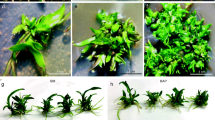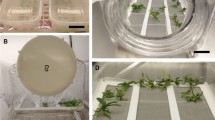Abstract
An efficient in vitro mass propagation through protocorm-like bodies (PLBs) was established in Cattleya forbesii Lindl., a commercially important orchid. Whole PLBs (W-PLB) and transverse thin cell layers of PLB (tTCL-PLB) explants were cultured in RITA® bioreactors based on temporary immersion system. Explants were transferred in semi-solid or RITA® bioreactor for protocorm production or shoot regeneration. The effect of different immersion frequencies, medium volumes and inoculum densities were studied and optimized. RITA® bioreactor cultures were found to be superior compared with semi-solid cultures regarding PLB production and shoot regeneration. tTCL-PLB explant types cultured in the RITA® bioreactor with immersion for 1 min/4 h, 250 mL of medium and 20 explants showed the highest number of PLBs per RITA® (2237 PLBs) and per explant (111.9 PLBs). The highest number of PLBs per explant was 21 times higher than those from semi-solid culture. The highest number of shoots per RITA® (3998 shoots) and per explant (199.9 shoots) were observed on tTCL-PLB cultured in RITA® bioreactor (1 min/4 h; 150 mL of medium and 20 explants). The highest number of shoots per explant was 95 times higher than those grown on semi-solid culture. Mass propagation of PLBs and shoots of C. forbesii Lindl. using combined thin cell layer and RITA® temporary immersion has been adapted in commercial practice.




Similar content being viewed by others
Change history
02 January 2019
In the original article, part a in Fig. 2 was incorrect. The correct Fig. 2 is printed below, and the first author’s current affiliation has been added.
References
Adelberg J, Pollock R, Rajapakse N, Young R (1998) Micropropagation, decontamination, transcontinental shipping and hydroponic growth of Cattleya while sealed in semipermeable membrane vessels. Sci Hortic 73:23–35. https://doi.org/10.1016/S0304-4238(97)00133-7
Almeida V, Pacheco de Freitas Fraga H, Bachiega Navarro B, Guerra MP, Pescador R (2017) Dynamics in global DNA methylation and endogenous polyamine levels during protocorm-like bodies induction of Cattleya tigrina A. Richard. Acta Sci Biol Sci 39(4):497–505. https://doi.org/10.4025/actascibiolsci.v39i4.36656
Bayraktar M, Hayta S, Parlak S, Gurel A (2015) Micropropagation of centennial tertiary relict trees of Liquidambar orientalis Miller through meristematic nodules produced by cultures of primordial shoots. Trees 29(4):999–1009. https://doi.org/10.1007/s00468-015-1179-2
Bose B, Kumaria S, Choudhury H, Tandon P (2017) Insights into nuclear DNA content, hydrogen peroxide and antioxidative enzyme activities during transverse thin cell layer organogenesis and ex vitro acclimatization of Malaxiswallichii, a threatened medicinal orchid. Physiol Mol Biol Plants 23(4):955–968. https://doi.org/10.1007/s12298-017-0474-3
Caballero-Villalobos L, Silva-Arias GA, Buzatto CR, Nervo MH, Singer RB (2017) Generalized food-deceptive pollination in four Cattleya (Orchidaceae:Laeliinae) species from Southern Brazil. Flora 234:195–206. https://doi.org/10.1016/j.flora.2017.07.014
Chugh S, Guha S, Rao IU (2009) Micropropagation of orchids: a review on the potential of different explants. Sci Hortic 122:507–520. https://doi.org/10.1016/j.scienta.2009.07.016
Colombo RC, Hoshino RT, Ferrari EAP, Alves GAC, de Faria RT (2017) Cattleya forbesii x Cattleya bowringiana: a new hybrid of Cattleya orchid. Crop Breed Appl Biotechnol 17:184–186. https://doi.org/10.1590/1984-70332017v17n2c28
Cozzolino S, Widmer A (2005) Orchid diversity: an evolutionary consequence of deception? Trends Ecol Evol 20(9):487–494
Cui HY, Murthy HN, Moh SH, Cui YY, Lee EJ, Paek KY (2014) Production of biomass and bioactive compounds in protocorm cultures of Dendrobium candidum Wall ex Lindl. using balloon type bubble bioreactors. Ind Crops Prod 53:28–33. https://doi.org/10.1016/j.indcrop.2013.11.049
De LC, Kumar R, Khan AM, Sangma R, Sailo N, Barman D (2014) Tropical and subtropical orchids. IJSAR 1(2):1–9
Escalona M, Lorenzo JC, González B, Daquinta M, González JL, Desjardins Y, Borroto CG (1999) Pineapple (Ananas comosus L. Merr) micropropagation in temporary immersion systems. Plant Cell Rep 18(9):743–748. https://doi.org/10.1007/s002990050653
Etienne H, Berthouly M (2002) Temporary immersion systems in plant micropropagation. Plant Cell Tissue Organ Cult 69:215–231. https://doi.org/10.1023/A:1015668610465
Gao R, Wu SQ, Piao XC, Park SY, Lian ML (2014) Micropropagation of Cymbidium sinense using continuous and temporary airlift bioreactor systems. Acta Physiol Plant 36:117–124. https://doi.org/10.1007/s11738-013-1392-9
Gatica-Arias A, Weber G (2013) Genetic transformation of hop (Humuluslupulus L. cv. Tettnanger) by particle bombardment and plant regeneration using a temporary immersion system. In Vitro Cell Dev Biol 49:656–664. https://doi.org/10.1007/s11627-013-9574-0
Jaiphet C, Rangsayatorn N (2010) Micropropagation of a rare orchid Dendrobium gratiosissimum using thin cell layers. Acta Hortic 878:185–189. https://doi.org/10.17660/ActaHortic.2010.878.21
Jena S, Ray A, Sahoo A, Sahoo S, Kar B, Chandra-Panda P, Nayak S (2018) High-frequency clonal propagation of Curcuma angustifolia ensuring genetic fidelity of micropropagated plants. Plant Cell Tissue Organ Cult. https://doi.org/10.1007/s11240-018-1480-z
Kamemoto H, Amore TD, Kuehnle AR (1999) Breeding Dendrobium orchids in Hawaii. University of Hawaii Press, Honolulu
Knudson L (1946) A new nutrient solution for germination of orchid seed. Am Orchid Soc Bull 15:214–217
Lakshmanan P, Lob CS, Gob CJ (1995) An in vitro method for rapid regeneration of a monopodial orchid hybrid Aranda Deborah using thin section culture. Plant Cell Rep 14:510–514. https://doi.org/10.1007/BF00232785
Lee YI (2018) Vegetative propagation of orchids. In: Lee YI, Yeung ET (eds) Orchid propagation: from laboratories to greenhouses—methods and protocols. Springer Protocols Handbooks, Humana Press, New York, pp 403–425. https://doi.org/10.1007/978-1-4939-7771-0_22
Mamun NHA, Egertsdotter U, Aidun CK (2015) Bioreactor technology for clonal propagation of plants and metabolite production. Front Biol 10(2):177–193. https://doi.org/10.1007/s11515-015-1355-1
McAlister B, Finnie J, Watt MP, Blakeway F (2005) Use of the temporary immersion bioreactor system (RITA®) for production of commercial Eucalyptus clones in Mondi Forests (SA). Plant Cell Tissue Organ Cult 81:347–358. https://doi.org/10.1007/s11240-004-6658-x
Murdad R, Hwa KS, Seng CK, Abd. Latip M, Abdul Aziz Z, Ripin R (2006) High frequency multiplication of Phalaenopsis gigantean using trimmed bases protocorms technique. Sci Hortic 111:73–79. https://doi.org/10.1016/j.scienta.2006.08.008
Murthy HN, Paek KY, Park SY (2018) Micropropagation of orchids by using bioreactor technology. In: Lee YI, Yeung ET (eds) Orchid propagation: from laboratories to greenhouses—methods and protocols. Springer Protocols Handbooks, Humana Press, New York, pp 195–208. https://doi.org/10.1007/978-1-4939-7771-0_9
Nayak NR, Sahoo S, Patnaik S, Rath SP (2002) Establishment of thin cross section (TCS) culture method for rapid micropropagation of Cymbidium aloifolium (L.) Sw. and Dendrobium nobile Lindl. (Orchidaceae). Scientia Horticult 94:107–116. https://doi.org/10.1016/S0304-4238(01)00372-7
Ng CY, Saleh NM (2011) In vitro propagation of Paphiopedilum orchid through formation of protocorm-like bodies. Plant Cell Tissue Organ Cult 105:193–202. https://doi.org/10.1007/s11240-010-9851-0
Park SY, Yeung EC, Chakrabarty D, Paek KY (2002) An efficient direct induction of protocorm-like bodies from leaf sub epidermal cells of Doritaenopsis hybrid using thin-section culture. Plant Cell Rep 21:46–51. https://doi.org/10.1007/s00299-002-0480-x
Parthibhan S, Rao MV, Teixeira da Silva JA, Kumar TS (2018) Somatic embryogenesis from stem thin cell layers of Dendrobium aqueum. Biol Plant. https://doi.org/10.1007/s10535-018-0769-4
Pérez-Alonso N, Wilken D, Gerth A, Jähn A, Nitzsche HM, Kerns G, Capote-Perez A, Jiménez E (2009) Cardiotonic glycosides from biomass of Digitalis purpurea L. cultured in temporary immersion systems. Plant Cell Tissue Organ Cult 99(2):151–156. https://doi.org/10.1007/s11240-009-9587-x
Ramos-Castellá A, Iglesias-Andreu LG, Bello-Bello J, Lee-Espinosa H (2014) Improved propagation of vanilla (Vanilla planifolia Jacks. ex Andrews) using a temporary immersion system. In Vitro Cell Dev Biol 50:576–581. https://doi.org/10.1007/s11627-014-9602-8
Rittirat S, Klaocheed S, Prasertsongskun S, Thammasiri K (2017) Asymbiotic seed germination and protocorm-like body proliferation of Cymbidium finlaysonianum Lindl. Acta Hortic. https://doi.org/10.17660/ActaHortic.2017.1167.15
Roels S, Escalona M, Cejas I, Noceda C, Rodriguez R, Canal MJ, Sandoval J, Debergh P (2005) Optimization of plantain (Musa AAB) micropropagation by temporary immersion system. Plant Cell Tissue Organ Cult 82:57–66. https://doi.org/10.1007/s11240-004-6746-y
Romero C, Cuba-Díaz M, Silva R (2017) In vitro culture of Chloraea gavilu Lindl., an endemic terrestrial orchid from Chile. Plant Biosyst. https://doi.org/10.1080/11263504.2017.1306001
Ross S, Castillo A (2009) Mass propagation of Vaccinium corymbosum in bioreactors. Agrociencia 13(2):1–8
Roy AR, Patel RS, Patel VV, Sajeev S, Deka BC (2011) Asymbiotic seed germination, mass propagation and seedling development of Vanda coerulea Griff ex. Lindl. (Blue Vanda): an in vitro protocol for an endangered orchid. Sci Hortic 128:325–331. https://doi.org/10.1016/j.scienta.2011.01.023
Schiff JL (2018) Rare and exotic orchids: their nature and cultural significance. Springer, New York. https://doi.org/10.1007/978-3-319-70034-2
Tee CS, Maziah M, Tan CS (2008) Induction of in vitro flowering in the orchid Dendrobium Sonia 17. Biol Plant 52(4):723–726. https://doi.org/10.1007/s10535-008-0139-8
Teisson C, Alvard D (1995) A new concept of plant in vitro cultivation liquid medium: temporary immersion. In: Terzi M, Cella R, Falavigna A (eds) Current issues in plant molecular and cellular biology. Springer, Dordrecht, pp 105–110. https://doi.org/10.1007/978-94-011-0307-7_12
Teixeira da Silva JA (2013) The role of thin cell layers in regeneration and transformation in orchids. Plant Cell Tissue Organ Cult 113:149–161. https://doi.org/10.1007/s11240-012-0274-y
Teixeira da Silva JA, Winarto B (2016) Somatic embryogenesis in two orchid genera (Cymbidium, Dendrobium). In: Germanà MA, Lambardi M (eds) in vitro embryogenesis in higher plants. Methods in molecular biology, vol 1359. Springer, New York, pp 371–386. https://doi.org/10.1007/978-1-4939-3061-6_18
Teixeira da Silva JA, Singh N, Tanaka M (2006) Priming biotic factors for optimal protocorm-like body and callus induction in hybrid Cymbidium (Orchidaceae), and assessment of cytogenetic stability in regenerated plantlets. Plant Cell Tissue Organ Cult 84:135–144. https://doi.org/10.1007/s11240-005-9003-0
Unruh SA, McKain MR, Lee Y-I, Yukawa T, McCormick MK, Shefferson RP, Smithson A, Leebens-Mack JH, Pires JC (2018) Phylotranscriptomic analysis and genome evolution of the Cypripedioideae (Orchidaceae). Am J Bot 105(4):631–640. https://doi.org/10.1002/ajb2.1047
van Le B, Phuong NTH, Hong LTA, Van KTT (1999) High frequency shoot regeneration from Rhynchostylis gigantean (Orchidaceae) using thin cell layers. Plant Growth Regul 28(3):179–185. https://doi.org/10.1023/A:1006210100775
Vyas S, Guha S, Kapoor P, Rao IU (2010) Micropropagation of Cymbidium Sleeping Nymph through protocorm-like bodies production by thin cell layer culture. Sci Hortic 123(4):551–557. https://doi.org/10.1016/j.scienta.2009.11.020
Winarto B, Rachmawati F, Santi A, Teixeira da Silva JA (2013) Mass propagation of Dendrobium ‘Zahra FR 62’, a new hybrid used for cut flowers, using bioreactor culture. Sci Hortic 161:170–180. https://doi.org/10.1016/j.scienta.2013.06.014
Yang JF, Piao XC, Sun D, Lian ML (2010) Production of protocorm-like bodies with bioreactor and regeneration in vitro of Oncidium ‘Sugar Sweet’. Sci Hortic 125:712–717. https://doi.org/10.1016/j.scienta.2010.05.003
Young PS, Murthy HN, Yoeup PK (2000) Mass multiplication of protocorm-like bodies using bioreactor system and subsequent plant regeneration in Phalaenopsis. Plant Cell Tissue Organ Cult 63(1):67–72. https://doi.org/10.1023/A:1006420116883
Zhang B, Song L, Bekele LD, Shi J, Jiab Q, Zhang B, Jin L, Duns GJ, Chen J (2018) Optimizing factors affecting development and propagation of Bletilla striata in a temporary immersion bioreactor system. Sci Hortic 232:121–126. https://doi.org/10.1016/j.scienta.2018.01.007
Zhao P, Wang W, Feng FS, Wu F, Yang ZQ, Wang WJ (2007) High-frequency shoot regeneration through transverse thin cell layer culture in Dendrobium candidum Wall Ex Lindl. Plant Cell Tissue Organ Cult 90:131–139. https://doi.org/10.1007/s11240-006-9181-4
Zhao P, Wu F, Feng FS, Wang WJ (2008) Protocorm-like body (PLB) formation and plant regeneration from the callus culture of Dendrobium candidum Wall ex Lindl. In Vitro Cell Dev Biol 44:178–185. https://doi.org/10.1007/s11627-007-9101-2
Acknowledgements
Authors are grateful to Republic of Turkey Ministry of Science, Industry, and Technology (Project No: 1217.STZ.2012-1), Ege University Scientific Research Projects Coordination Unit (Project No: 13-BIL-022) and Ön Danışmanlık Tourism Commitment and Trade Limited Company. In addition, we would like to thank Didem Ökmen, Biomedicine and Genome Center, Bioinformatics Department PhD student for her contributions to statistical analyzes and interpretations.
Author information
Authors and Affiliations
Contributions
ME performed all experiments and wrote the manuscript. MB wrote the manuscript. ÖA calculated all statistical analyses and interpreted the data. AG supervised the research and edited and reviewed this manuscript. All authors designed research, read and approved the manuscript.
Corresponding author
Ethics declarations
Conflict of interest
The authors declare that they have no conflict of interest.
Additional information
Communicated by Maurizio Lambardi.
Electronic supplementary material
Below is the link to the electronic supplementary material.
Rights and permissions
About this article
Cite this article
Ekmekçigil, M., Bayraktar, M., Akkuş, Ö. et al. High-frequency protocorm-like bodies and shoot regeneration through a combination of thin cell layer and RITA® temporary immersion bioreactor in Cattleya forbesii Lindl.. Plant Cell Tiss Organ Cult 136, 451–464 (2019). https://doi.org/10.1007/s11240-018-1526-2
Received:
Accepted:
Published:
Issue Date:
DOI: https://doi.org/10.1007/s11240-018-1526-2




